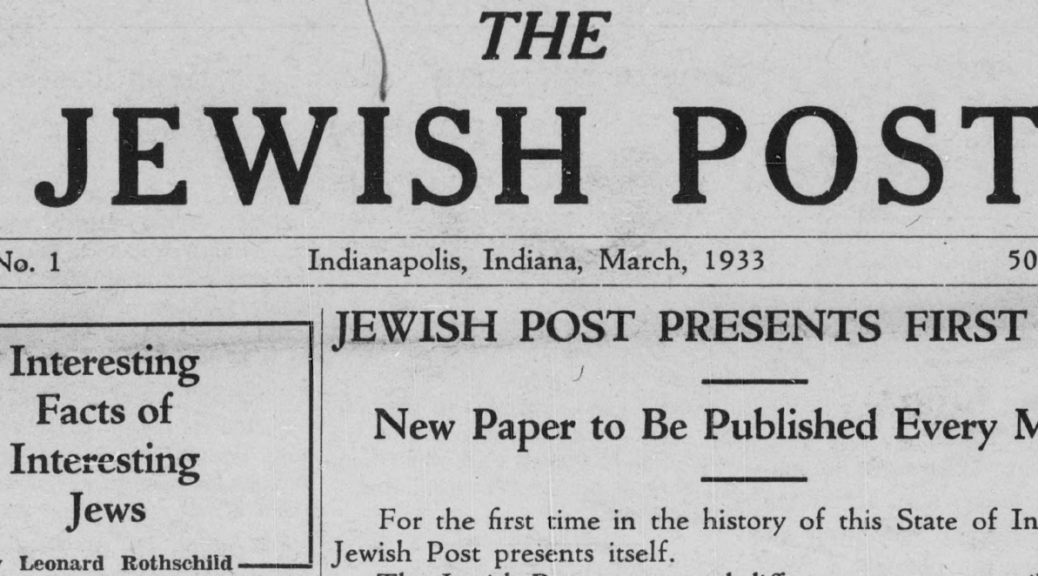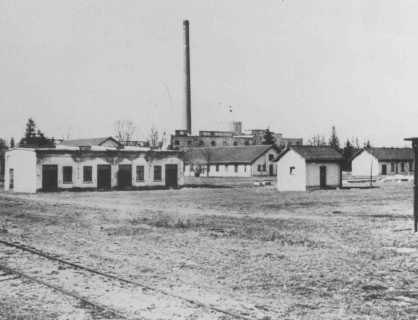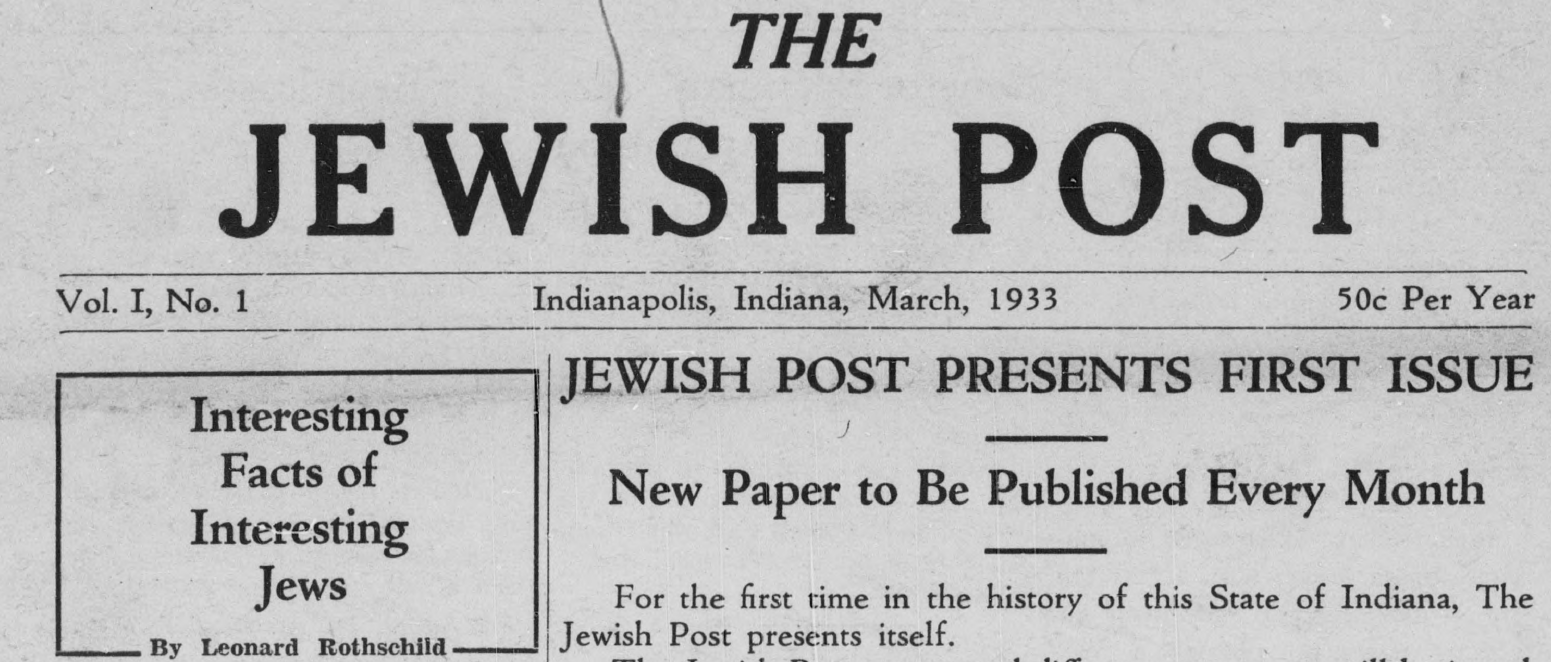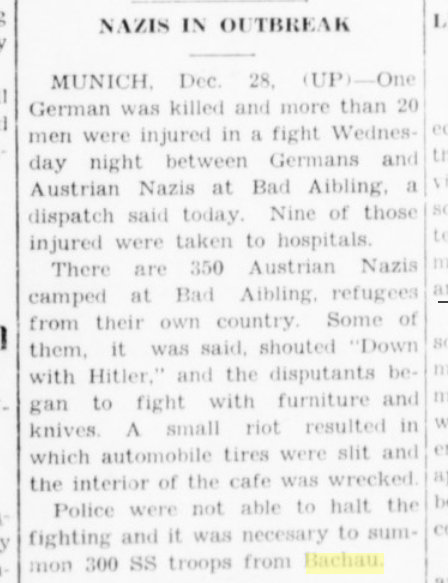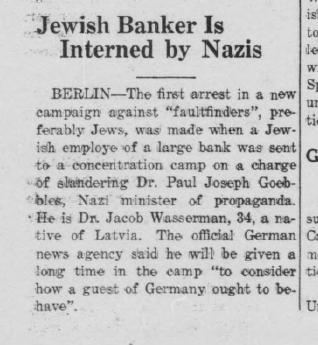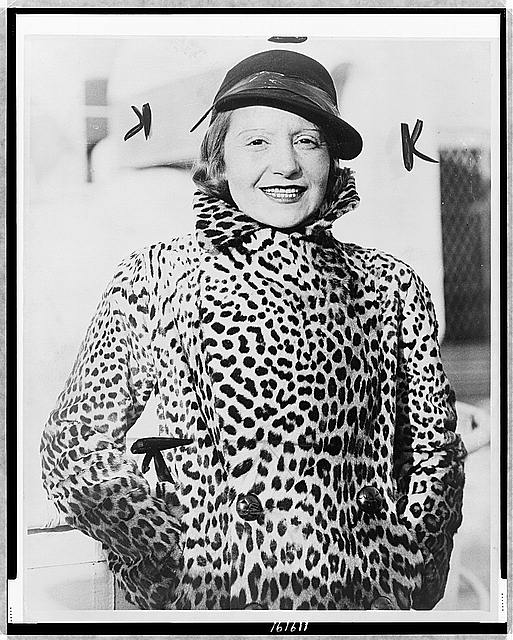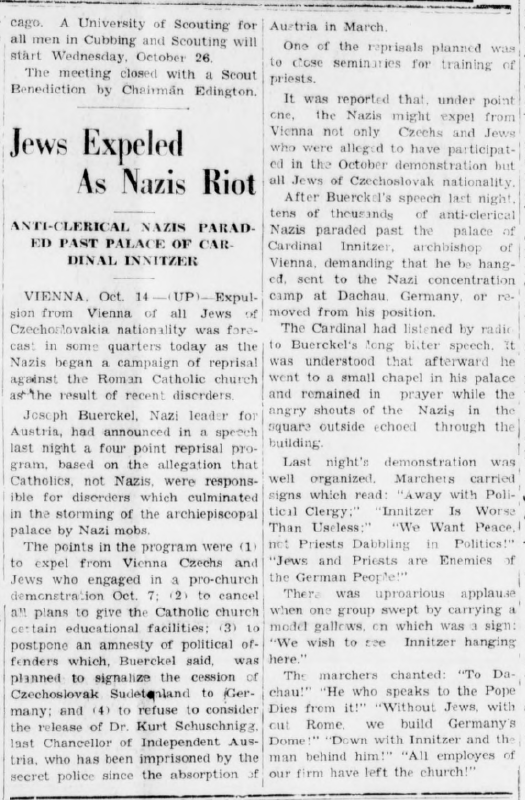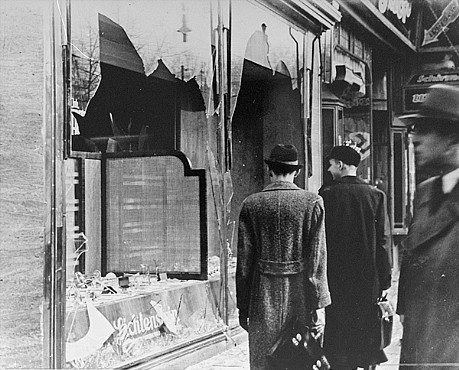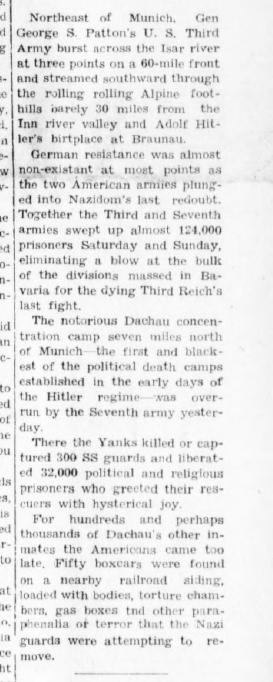For this project, we are examining world events through the eyes of the Hoosier newspaper reader. Because many of these articles were reported through the Associated Press and United Press news services, what we are really seeing is not just what Hoosiers knew, but what the average American knew, about the events leading up to the Holocaust.
 Over the next several months, we will be contributing newspaper articles to the United States Holocaust Memorial Museum‘s project titled History Unfolded: US Newspapers and the Holocaust. Using digitized newspapers mainly accessible via Hoosier State Chronicles, we are looking at key events suggested for research by the museum to see what Hoosiers knew when. The overall goal of the project is to contribute to the scholarship on how American media reported and under-reported Nazi atrocities. Anyone can submit their research; find out how at History Unfolded.
Over the next several months, we will be contributing newspaper articles to the United States Holocaust Memorial Museum‘s project titled History Unfolded: US Newspapers and the Holocaust. Using digitized newspapers mainly accessible via Hoosier State Chronicles, we are looking at key events suggested for research by the museum to see what Hoosiers knew when. The overall goal of the project is to contribute to the scholarship on how American media reported and under-reported Nazi atrocities. Anyone can submit their research; find out how at History Unfolded.
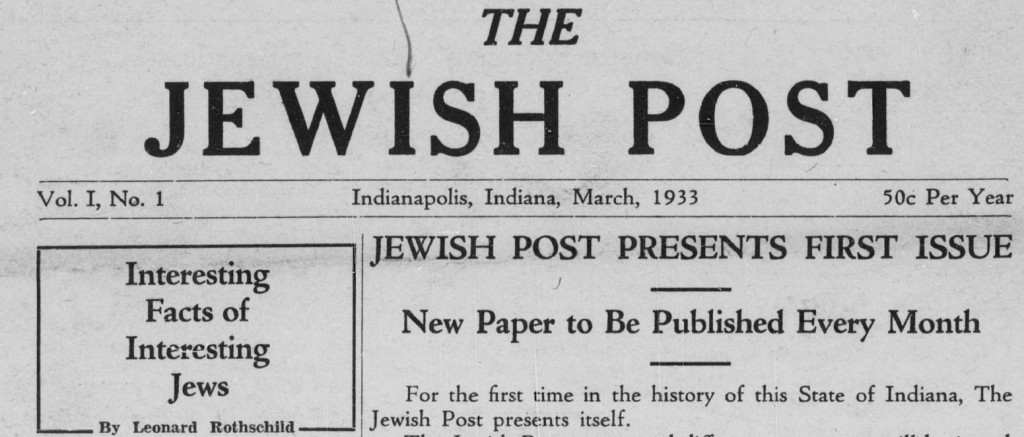
In Part 1, we asked: When did Hoosiers learn about the opening of the Dachau concentration camp? For this post, Part 2, we are looking into Indiana newspapers to find out when and what Hoosiers learned about the Nazi boycott of Jewish businesses and the removal of Jewish leaders from government posts during the spring of 1933.
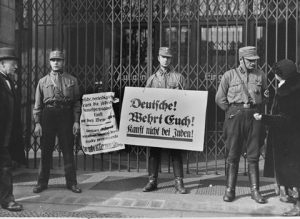
On April 1, 1933, Nazis organized a boycott of Jewish-owned businesses throughout Germany. According to the United States Holocaust Memorial Museum (USHMM), the boycott, “marked the beginning of a nationwide campaign by the Nazi party against the entire German Jewish population.” The Nazis presented the boycott as retaliatory, but we know this was not the case. What did Hoosiers know at the time, considering they were reading United Press and Associated Press articles which sometimes repeated propaganda compiled by Nazi communications directors?
To get the whole story, we need to start at least a month before the boycott. According to the USHMM, “In March 1933, the SA (Storm Troopers) attacked Jewish-owned department stores in German cities in an attempt to segregate Jews from the rest of society.” Additionally, SA members took Jewish lawyers and judges from courtrooms into the streets and publicly humiliated them. The international press and organizations condemned these acts, which Nazis denied despite evidence, and called for a boycott of German goods. Nazi leaders claimed the press was biased against them and blamed Jewish German citizens for reporting false stories. The Nazi Party called for a nationwide boycott of Jewish businesses.

The earliest article that we located directly tied to this rising storm, was published in the very first issue of the new (Indianapolis) Jewish Post on March 10, 1933. The short article on the second page of the paper reported that Nazi Storm Troops arrested Jewish business owners in Annaberg, Germany, and closed their shops. Unfortunately, this is also the only issue of the Jewish Post currently available in Hoosier State Chronicles for the year 1933, so we don’t know what other information Jews in Indianapolis received about the situation. Most Indiana residents would not have had access to this newspaper, however, so looking at newspapers that published articles from press associations tells us even more about what the average Hoosier knew.
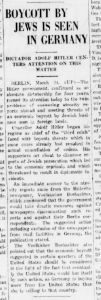
On March 24, 1933, the Greencastle Daily Banner printed a United Press (UP) article titled, “Boycott by Jews is Seen in Germany: Dictator Adolf Hitler Centers Attention on This Matter.” This one short article shows the powerful Nazi propaganda machine in motion, along with the muted threat of censorship and hints of violence. The article reported from Berlin that Hitler was focused on “the twin problems of answering atrocity reports abroad and meeting threats of an economic boycott by Jewish business men in foreign lands.” Reportedly, Hitler supporters were working to “disprove reports of Jewish persecution,” though no mention was made of how this would be accomplished. The same article reported that the Nazi newspaper Völkischer Beobachter announced that “the government would take drastic measures against newspapers disseminating such reports and against their Berlin correspondent.”
On March 27, the Banner ran another UP article announcing “Jews To Be Ousted from High Posts.” Again reporting from Berlin, the article quoted the “chief of the foreign press section” of the Nazi organization, Ernst Hanfstaengl. He told the press that Jewish leaders would be ousted from government and “influential” positions “until the house is cleansed.” Hanfstaengl claimed that Jewish leaders and government officials were removed because they abused their positions “morally, financially and politically,” resulting in the crumbling of the German people. He claimed they were trying to “smirch Germany’s renaissance.” Hanfstaengl also denied reports of widespread atrocities against the Jewish people in a manner that still managed to be threatening. He stated, “If we wanted to conduct a pogrom against the Jews it would all have been over now.”

Another short UP article on the same page reported: “Retaliatory measures against Jews in Germany were decided on by the Nazi party today to balance the ‘atrocity propaganda’ being circulated in foreign countries.” It is interesting that those creating Nazi propaganda were calling the international criticism of Nazi treatment of Jews “atrocity propaganda.” The article continued: “Retaliation will take the form of a boycott of Jewish goods and shops, a sharp reduction of the number of Jewish students permitted at German universities, and curtailment of the licenses granted to practicing Jewish physicians and lawyers.”
This attitude was much different than that of only a few years before, and would get much worse within a few years. According to the USHMM, before 1933:
Jews held important positions in government and taught in Germany’s great universities. Of the thirty-eight Nobel Prizes won by German writers and scientists between 1905 and 1936, fourteen went to Jews. Marriage between Jews and non-Jews was becoming more common. Although German Jews continued to encounter some discrimination in their social lives and professional careers, most were confident of their future as Germans.
On March 29, 1933, the Columbus Republic ran an AP article that mainly focused on the arrest of members of the “steelhelmets,” a paramilitary organization. However, the second half of the article, addressed the boycott and the continued effort to deny reports of atrocities. The article reported: “The Nazi ‘anti-lie’ campaign to offset widespread reports of persecution of the Jews has taken the form of a general boycott of Jewish shopkeepers and professional men.” The article also reported that the German government, still somewhat separate at this time from the Nazi Party, would not interfere.
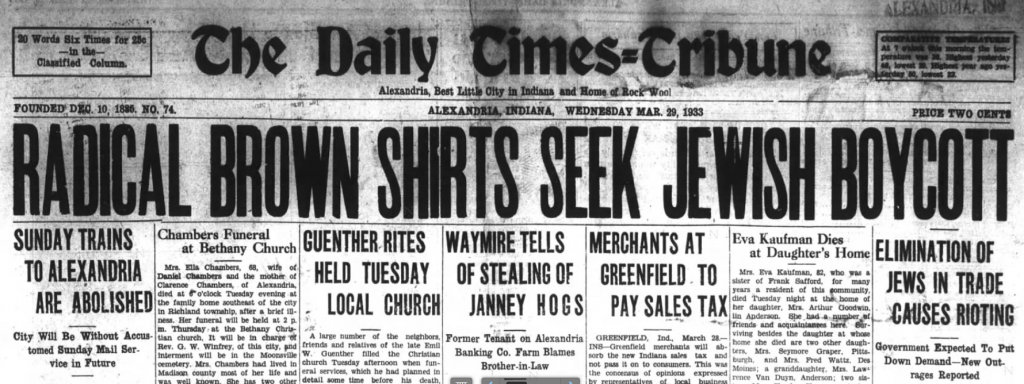
On March 29, 1933, the planned boycott made front page headlines of at least a few Indiana newspapers. The Alexandria Times-Tribune reported on an alleged split in the Nazi Party concerning the boycott and the treatment of Jewish citizens. The article, titled “Elimination of Jews in Trade Causes Rioting” reported: “The radical element of the Nazis demanded boycott measures which amount to the practical extermination of Jews or their reduction to a position of serfdom.” The use of the word “extermination,” even here in reference to their position in society, is haunting. This article, clearly regurgitating Nazi propaganda, naively positions Hitler as a moderate within his party and distances him from the boycott. The article continued, “Chancellor Hitler and his close advisors, while of a determination to curb Jewish influence in politics and industry and commerce, took a more liberal view of the problem.” The article ponders whether the “liberal” Hitler would be able to curb the “radical” Nazis without dividing the party. The article went on to describe the plan for the April 1 boycott:
The boycott plan, put forward by the Nazi radicals, calls for the clamping down the lid on all Jewish business and professional activities on April 1. Unless the government is able to forestall it, no phase of Jewish life, judging from the proclamation issued at National Socialist party headquarters in Munich will be spared. Jewish merchants, doctors and lawyers will be targets of the campaign as well as Jewish children, to whom the Nazi pronunciamento would bar certain professions and even would prevent extensive attendance by Jewish children in the schools.
According to the same article, a terrifying communique issued from Nazi headquarters in Munich titled, “For the defense of the Nazi party against the atrocity propaganda” explained that committees would be formed to carry out the boycott. It included the statement: “These committees will see to it that the innocent do not suffer, but they must not spare the guilty.”

The aforementioned article from the (Alexandria) Times-Tribune and another from the (Greencastle) Daily Banner on the same day (March 29) reported to Hoosiers on the “spontaneous” boycotts, business closings, and violence leading up to the official April 1 boycott. The Times-Tribune reported:
- “In one Silesian town Jews were forced to close their stores and pay two months wages to their employes [sic].”
- “At Bitterfeld, near Berlin, Nazi groups closed up Jewish market stalls and ordered their proprietors out of town.”
- “Unidentified men swinging clubs damaged a store at Neumünster which opened after having been closed for two weeks by the police. They drove out customers, broke windows, and upset counters.”
- “Boycott demonstrations extended to the offices of Jewish lawyers. At various places these lawyers were ordered to pay off their employes [sic] and closed their doors.”
The Daily Banner reported:
- “In Wittenburg and the province of Brandenburg, Hitler’s storm troops picketed Jewish shops and forced them to close.”
- “All stores owned by Jewish proprietors were closed in Darmstadt.”
- “Jews of Gleiwitz voluntarily closed during the morning and found their places of business officially closed by the dictator’s storm troops when they sought to open them in the afternoon.”
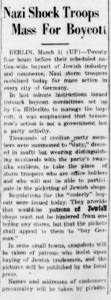
On March 31, the Banner ran another AP article on the impending boycott, reporting: “Twenty-four hours before their scheduled nation-wide boycott of Jewish industry and commerce, Nazi storm troopers mobilized today for mass action in every city of Germany.” The article reported that the German government stated that the boycott was not a government activity but a Nazi Party action. Those party members who also held a government position could not participate. They were to be replaced by “thousands of civilian party members… summoned to ‘duty’ . . . wearing distinguishing armbands with the party’s swastika emblem.” The article also reported that in some towns, patrons who ignored the boycott and shopped at a Jewish business, would have their photograph taken and published in their local newspaper and their names and addresses recorded by the SA.
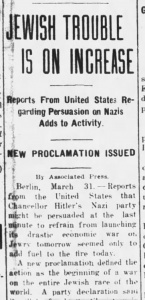
That same day, the Seymour Tribune ran an AP article reporting that attempts to persuade the Nazi Party to abandon the boycott “seemed only to add fuel to the fire today.” Instead of backing down, the party released a defiant statement. The article reported: “A new proclamation defined the action as the beginning of a war on the entire Jewish race of the world.” According to the article, Jewish business owners had been instructed to identify their stores by hanging yellow signs in their windows. The Nazi newspaper reported “World Jewry will receive a blow from which it will not easily recover. German Jewry will be done for morally and commercially. No pardon will be given; no compromises made.”
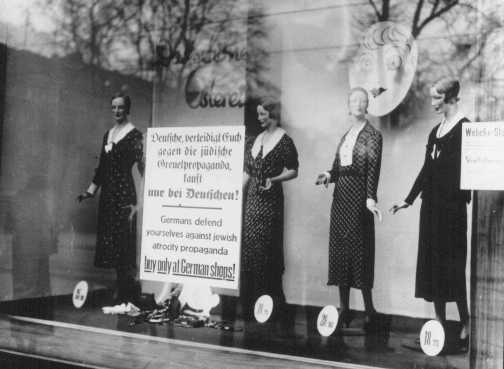
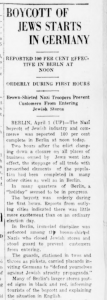
On April 1, 1933, the day of the official boycott, several Indiana newspapers covered the day’s events. The Greencastle Daily Banner ran an UP article stating that the “Nazi boycott of Jewish industry was reported 100 per cent complete in Berlin at noon today” and “the stoppage of all trade with proscribed elements of the population had been completed in many other cities as well as Berlin.” The atmosphere was described as being similar to that of a “holiday” and as “orderly.” However, the description of the Nazi party members stationed outside of stores was more menacing. SA members were stationed in pairs in front of Jewish businesses and held signs with slogans such as “defend yourselves against Jewish atrocity propaganda.” One sign even read: “Dangerous to life to buy here.”
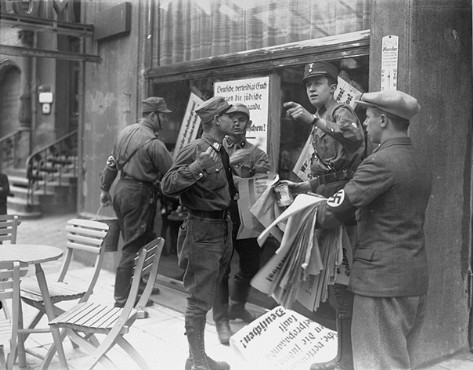
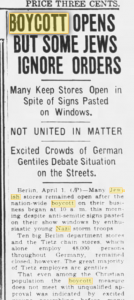
An AP article from the day of the protest and published by the Columbus Republic had a different report. The article titled “Boycott Opens But Some Jews Ignore Orders,” claimed that while some Jewish businesses closed under pressure, others defied Nazi orders. The article reported: “Many Jewish stores remained open after the nation-wide boycott on their business began at 10 a.m. this morning despite anti-Semitic signs pasted on their windows by enthusiastic young Nazi storm troops.” Nonetheless the Nazis were out in force. The article described the scene in Berlin:
“Brown shirted Nazis busily moved to and fro pasting signs of identification on Jewish stores, standing guard or picketing before shops and driving through streets in motor cars displaying boycott signs. On many public squares and market halls the Nazi brass bands made the air reverberate with snappy military marches. The Nazi Swastika and Imperial flags were displayed on all streetcars. Shops whose owners were Nazi party members, flew especially large Swastika banners.”
As with the earlier, nonofficial boycotts, the article reported that lawyers, physicians, and judges were also targeted. The article closed by stating that the Nazi Women’s Federation appealed to every German woman “to join the movement for the destruction of Jewry.”
Also on the day of the boycott, the Kokomo Tribune ran an AP article that can perhaps be read as more insightful than some of the other articles, especially the UP articles. The article titled “Shops Closed, Trade Halted by Hitlerites,” reported that although the German government was able to hold the Nazi boycott to one day, much permanent damage had been done. The AP stated, “Only a small comfort was derivable from the present limitations for a half million distracted German Jews who to all practical purposes already are ostracized.” The article also decried the removal of Jews from the courts and legal practices, of Jewish doctors from hospitals, and of Jewish leaders from other institutions. “Doors were being closed to them all around,” the article continued. Joseph Goebbels, the recently declared minister of Nazi propaganda, also threatened Jewish allies abroad, stating that if the English and Americans joined a Jewish-led boycott of German goods, Germany would “take its gloves off.”
Articles on the boycott and the removal of Jews from positions of leadership dwindled over the next several days and weeks. Several Indiana newspapers, including the Greencastle Daily Banner, ran the following photograph and caption:
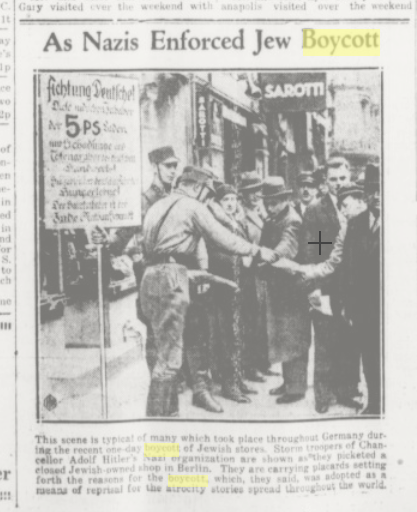
During our digital newspaper search, we discovered only one editorial in an Indiana newspaper responding to the reports. In a scathing denunciation of Nazi persecution of German Jews, the Indianapolis Recorder, the leading Indiana African American newspaper, stated on April 8, 1933:
 “Indiscriminate persecution of Jews throughout the so-called Republic of Germany has aroused the indignation of the entire civilized world. The anti-Jewish boycott imposed by the Nazi party was enforced in a spirit of savage spite by Hitler’s storm troops and other disciples of Germany’s administration . . . What took place at the behest of Germany’s Gentiles against the Jews of that troubled country was virtually a revolution on a mild scale. It was plainly a burst of long pent up race hatred, prejudice and treachery . . .it was a bold mockery of civilization; a slap in the face of common justice and fair play. By participating in what is now regarded throughout the world as their official and totally unnecessary reign of terror against the Jews of their native land the German people have committed a crime against society, the consequences of which they are bound the suffer eventually . . . World peace was never in such jeopardy as it is today, and since the assumption of power of Germany’s dictator. Treatment of Jews in Germany by its Nazi party headed by Hitler is condemnable to the core.” (Read the entire editorial through Hoosier State Chronicles).
“Indiscriminate persecution of Jews throughout the so-called Republic of Germany has aroused the indignation of the entire civilized world. The anti-Jewish boycott imposed by the Nazi party was enforced in a spirit of savage spite by Hitler’s storm troops and other disciples of Germany’s administration . . . What took place at the behest of Germany’s Gentiles against the Jews of that troubled country was virtually a revolution on a mild scale. It was plainly a burst of long pent up race hatred, prejudice and treachery . . .it was a bold mockery of civilization; a slap in the face of common justice and fair play. By participating in what is now regarded throughout the world as their official and totally unnecessary reign of terror against the Jews of their native land the German people have committed a crime against society, the consequences of which they are bound the suffer eventually . . . World peace was never in such jeopardy as it is today, and since the assumption of power of Germany’s dictator. Treatment of Jews in Germany by its Nazi party headed by Hitler is condemnable to the core.” (Read the entire editorial through Hoosier State Chronicles).
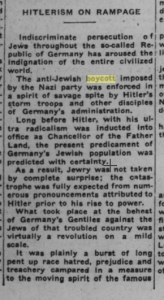
According to the USHMM, the official boycott only lasted one day, but it was the beginning of a systematic campaign against the Jewish people by the Nazi Party. Over the following weeks, several laws were passed officially removing Jews from civil service, government work, schools and universities, courts, and hospitals. Jews feared first for their livelihood, then for their lives. According to William L. Shirer in The Rise and Fall of the Third Reich, by the time the boycott was organized, Hitler had “publicly declared a thousand times, Jews were not Germans” [page 203]. It was not long before they were not only not considered citizens, but also not considered human.
Please visit the United States Holocaust Memorial Museum’s summary of the boycott for more information, photographs, and the personal stories of survivors. Hoosiers can learn more about the Holocaust and its survivors through CANDLES Holocaust Museum and Education Center in Terre Haute, Indiana.
Check back in February for Part 3 on our History Unfolded project for a new post on the May 10, 1933 book burnings.


